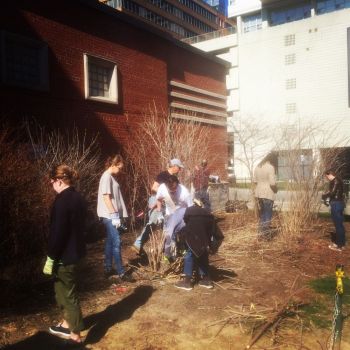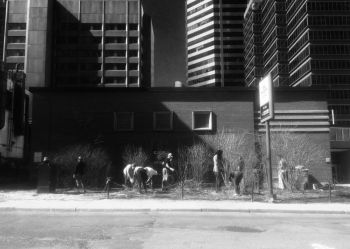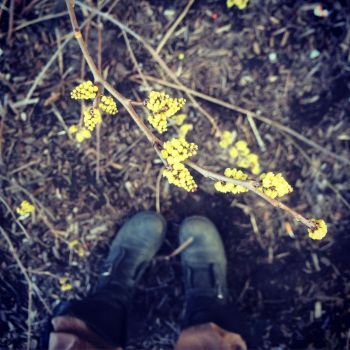This year, as the days got longer and the growing season came closer, the sight of my balcony garden - an assortment of native species planted last spring to mimic a forest edge near a river, including vines, ferns, shrubs and wildflowers - convinced me that it was time to overcome my fears and learn how to prune by attending a LEAF workshop held in the demonstration garden at the St. Clair TTC Station in Toronto.
The workshop was led by a professional pruner (Ryan Kuz of KarmaTree), who began the session with a discussion of why we prune. Although images of meticulously manicured gardens may come to mind, our conversation centered on promoting the health of the garden by focusing on the Four D's - Dead, Damaged, Diseased, and Defective growth. I found dead plant material to be the easiest and least intimidating place to start, because mistakes there would have the least significant consequences and could be corrected later. In spring, dead material can be identified by discoloration and an absence of new growth. Removing this dieback can help reduce crowding, and the increased light penetration and air circulation may reduce the risk of rotting.

Removing
dead material gave me a chance to get comfortable identifying and using the
appropriate tools for different tasks- snips for precise cuts in tight spaces,
bypass shears for branches up to an inch in diameter, and folding pruning saws
for anything thicker. Our guide showed us how and why we use each tool,
demonstrated techniques to minimize damage to the plant, and pointed out common
mistakes and their consequences. By the time the dead material was all cleared,
I had become comfortable with the equipment, and the garden looked much better.

With all the dead material out of the way, it became easier to see signs of damage in the remaining plant material. This damage can be caused by storms, animals, or human activity, and can serve as an entry point for diseases and pests – we removed any damaged matter to help prevent further problems.. Had we found any evidence of disease, we would have also excised any affected material to prevent the pathogen’s spread (taking care to disinfect our shears with diluted bleach between cuts). Finally, we looked for defective growth, such as crossed branches or branches that rub against the trunk, which can eventually cause damage. By removing this growth before it becomes a problem, we can protect the plants' wellbeing and reduce maintenance needs in the future.

By the end of the afternoon, I had a clear understanding of which tools I would need to prune my balcony garden and how to use them effectively. A few hours of experienced instruction and guided hands-on practice transformed my anxiety into the confidence I need to continue nurturing my environment. Best of all, I met terrific people, some of whom I'll be seeing regularly as we keep our pruning skills (and shears) sharp in LEAF’s Urban Forest Demonstration Gardens.
Alexander Garcia Muradov is a LEAF volunteer, David Suzuki Foundation HGNP ranger, and lecturer in the University of Toronto's Faculty of Applied Science and Engineering. “Cultivo una rosa blanca.'" (Quotation is a reference to my father's favourite poem by the revolutionary, poet, and Cuban national hero Jose Marti.)
LEAF’s Urban Forest Demonstration Gardens are supported Ontario Power Generation’s Biodiversity Program and the Toronto Transit Commission.
